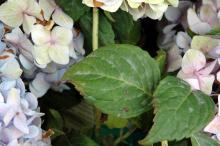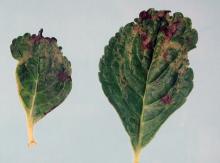Cause Erysiphe friesii var. friesii (formerly Microsphaera friesii) has been reported from Washington and Erysiphe polygoni has been reported from British Columbia. These fungi are favored by conditions that produce high humidity but dry leaves such as heavily-shaded growing sites. It is a highly specialized pathogen that forms a close association with the host. Conditions that favor the host also favor the pathogen. Much of the fungus remains outside infected plant parts where it grows on the surface but sinks root-like structures called haustoria into plant cells to obtain nutrients. The white growth seen is composed of both mycelium and spores of the fungus.
The cultivar Veitchii was found to be resistant, 'Nikko Blue' was susceptible, and 'Madame Emile Mouilliere', 'Forever Pink', 'Lilacina', and 'Holstein' were intermediate; while 'Preziosa' is very susceptible.
Symptoms Leaves' undersides are covered with a white powdery growth; upper surfaces develop yellowish green blotches or turn purplish brown. Leaves may become completely covered and die early. Leaf distortion can occur when attacked early as leaves are expanding. Premature defoliation may occur on severely infected plants. Reduced leaf area and shoot elongation are also possible. Blooms may become stunted and malformed.
Cultural control
- Keep greenhouse humidity low.
- Space plants for good air circulation.
- Plant or move bushes in the landscape to sunnier locations.
- Plant resistant cultivars.
Chemical control Fungicides will do best when used before symptoms develop. Few materials have good eradicant activity alone so add an adjuvant in these cases. Use at 7- to 14-day intervals; using shorter intervals when environmental conditions favor disease development. Alternate or tank-mix products from different groups that have different modes of action. Limit the use of any one group during crop production. Limit the use of any one group during crop production.
- Armada 50 WDG at 3 to 9 oz/100 gal water. Do not use a silicone-based surfactant. Not for nursery or greenhouse use. Group 3 + 11 fungicide. 12-hr reentry.
- Avelyo at 3 to 5 fl oz/100 gal water. Group 3 fungicide. 12-hr reentry.
- Banner MAXX at 5 to 8 fl oz/100 gal water. Group 3 fungicide. 12-hr reentry.
- Bicarbonate-based products. Might be used to supplement a normal program when powdery mildew is first observed. Do not mix with acidifying agents. Thorough coverage is essential. O
- MilStop SP (85% potassium bicarbonate) at 2.5 to 5 lb/A in the field or 1.25 to 5 lb/100 gal water in the greenhouse. Oregon and Washington only. 1-hr reentry.
- Monterey Bi-Carb Old Fashioned Fungicide at 4 teaspoons/2 gal water. H
- Broadform at 2 to 4 fl oz/100 gal water. Group 7 + 11 fungicide. 12-hr reentry.
- Camelot O at 0.5 to 2 gal/100 gal water. 4-hr reentry.
- Compass 50 WDG at 1 to 2 oz/100 gal water plus an adjuvant. Do not use organosilicate additives. Group 11 fungicide. 12-hr reentry.
- Eagle 20 EW at 6 to 12 fl oz/100 gal water. Not labelled for this pest, but highly effective against powdery mildews in general. Group 3 fungicide. 24-hr reentry.
- Grotto at 0.5 to 2 gal/30 to 100 gal water/A. Group M1 fungicide. 4-hr reentry.
- Heritage at 1 to 4 oz/100 gal water plus a non-silicone-based wetter sticker. Group 11 fungicide. 4-hr reentry.
- Insignia SC at 3 to 6 fl oz/100 gal water plus an adjuvant. Do not use with organosilicate-based adjuvants. Use preventively only. Group 11 fungicide. 12-hr reentry.
- KleenGrow at 6 to 38 fl oz/100 gal water. 48-hr reentry.
- Mural at 4 to 7 oz/100 gal water. Group 7 + 11 fungicide. 12-hr reentry.
- Myclobutanil 20 EW T&O at 6 to 12 fl oz/100 gal water plus spreading agent. May observe a PGR effect. Group 3 fungicide. 24-hr reentry.
- OHP 6672 4.5 F at 10 to 20 fl oz/100 gal water. Group 1 fungicide. 12-hr reentry.
- Orkestra at 6 to 8 fl oz/100 gal water. Group 7 + 11 fungicide. 12-hr reentry.
- Ortho Rose & Flower Disease Control at 2 fl oz/gal water. Group 3 fungicide. H
- Pageant at 6 to 12 oz/100 gal water. Do not use with organosilicone-based adjuvants. Group 7 + 11 fungicide. 12-hr reentry.
- Pipron at 4 to 8 fl oz/100 gal water. Do not treat after flower buds are visible. Greenhouse production only. Group 5 fungicide. 12-hr reentry.
- Postiva at 10 to 28 fl oz/100 gal water. Group 3 + 7 fungicide. 12-hr reentry.
- Seido at 4 to 5 fl oz/100 gal water plus an adjuvant. Group 50 fungicide. 4-hr reentry.
- Spectracide Immunox Multi-Purpose Fungicide Spray Concentrate for Gardens at 1 fl oz/gal water. Group 3 fungicide. H
- Terraguard SC at 2 to 8 fl oz/100 gal water. 12-hr reentry.
- Tourney EZ at 1 to 4 oz/100 gal water. Group 3 fungicide. 12-hr reentry.
- Trinity at 4 to 12 fl oz/100 gal water. Group 3 fungicide. 12-hr reentry.
Biological control Thorough coverage of all leaf surfaces is essential.
- Cease or Rhapsody (Bacillus subtilis strain QST 713) at 2 to 8 quarts/100 gal water. Active ingredient is a small protein. Efficacy in the Pacific Northwest is unknown. 4-hr reentry. O
Reference Hagan, A.K., Olive, J.W., Stephenson, J., and Rivas-Davila, M.E. 2004. Impact of application rate and interval on the control of powdery mildew and Cercospora leaf spot on bigleaf hydrangea with azoxystrobin. Journal of Environmental Horticulture. 22:58-62.


